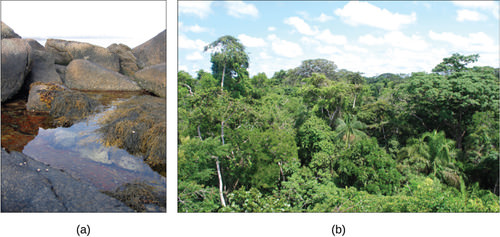
An ecosystem is a community of organisms and their abiotic (non-living) environment. Ecosystems can be small, such as the tide pools found near the rocky shores of many oceans, or large, such as those found in the tropical rainforest of the Amazon in Brazil (Figure 1).
There are three broad categories of ecosystems based on their general environment: freshwater, marine, and terrestrial. These three categories are individual ecosystem types based on the environmental habitat and organisms present.
Freshwater ecosystems are the least common, occurring on only 1.8 percent of Earth’s surface. These systems comprise lakes, rivers, streams, and springs; they are quite diverse and support a variety of animals, plants, fungi, protists, and prokaryotes.
Marine ecosystems are the most common, comprising 75 percent of Earth’s surface and consisting of three basic types: shallow ocean, deep ocean water, and deep ocean bottom. Shallow ocean ecosystems include extremely biodiverse coral reef ecosystems. Small photosynthetic organisms suspended in ocean waters, collectively known as phytoplankton, perform 40 percent of all photosynthesis on Earth. Deep ocean bottom ecosystems contain a wide variety of marine organisms. These ecosystems are so deep that light is unable to reach them.
Terrestrial ecosystems, also known for their diversity, are grouped into large categories called biomes. A biome is a large-scale community of organisms primarily defined on land by the dominant plant types that exist in geographic regions of the planet with similar climatic conditions. Examples of biomes include tropical rainforests, savannas, deserts, grasslands, temperate forests, and tundras. Grouping these ecosystems into just a few biome categories obscures the great diversity of the individual ecosystems within them. For example, the saguaro cacti (Carnegiea gigantean) and other plant life in the Sonoran Desert in the United States are relatively diverse compared with the desolate rocky desert of Boa Vista, an island off the coast of Western Africa (Figure 2).
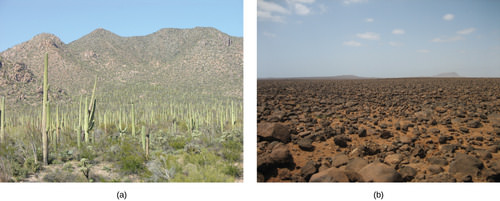
Ecosystem Services
An ecosystem is a dynamic complex of plant, animal, and microorganism communities and the nonliving environment interacting as a functional unit, while ecosystem services are the benefits people obtain from ecosystems. Ecosystem services are critical to human well-being and sufficiently diverse and numerous to justify classification into four major categories.
- Provisioning ecosystem services are actively harvested by us from the natural world to meet our resource needs, e.g., food, water, timber, and fiber.
- Regulating ecosystem services are processes in the Earth system that control key physical and biological elements of our environment, e.g., climate regulation, food regulation, disease regulation, and water purification.
- Cultural ecosystem services reflect the aesthetic and spiritual values we place on nature, as well as the educational and recreational activities dependent on ecosystems.
- Supporting ecosystem services are the biogeochemical cycles and biological and physical processes that drive ecosystem function, e.g., soil formation, nutrient cycling, and photosynthesis.
We benefit from the services associated with both pristine, natural ecosystems, such as tropical rain forests or arctic tundra, and highly managed ecosystems, such as crop fields or urban landscapes. In all cases, ecosystems contribute to human well-being by influencing the attainability of basic material needs (e.g., food and shelter), health (e.g., clean air and water), good social relations and security (i.e., sufficient resources to avoid conflict, tolerate natural and man-made disasters, provide for children, and maintain social cohesion), as well as freedom of choice and action (an inherent component of the other elements of well-being is the right to live as one chooses). Linkages between some ecosystem services and human well-being vary in strength depending on socio-economic status. For example, many people in developed countries can always afford to buy imported food without dependence on the yields of locally grown crops, thereby avoiding shortages when yields are low because of bad weather. However, in other cases, our ability to control the impact of losing an ecosystem service on human well-being is limited. For example, despite major engineering efforts, flooding still causes considerable human and economic damage in developed countries. The challenge of sustainable development stems from the need to benefit from and manage ecosystem services without causing damage to the ecosystems and Earth system that will reduce their value in the longer term. People have long recognized that some ways of using natural resources are unsustainable, especially where ecosystems are rapidly exploited to the maximum extent possible and further access to the ecosystem services can be achieved only by moving on to previously unexploited areas, as in the case of slash and burn agriculture. Only more recently have we come to appreciate that human activity is altering global-scale phenomena, such as climate regulation, and this understanding raises a host of difficult questions. That is because people in one locale may realize the benefits of an ecosystem service, while the costs (in the form of negative environmental consequences) are imposed on people who live elsewhere and may be less equipped to withstand them.
Food Chains and Food Webs
A food chain is a linear sequence of organisms through which nutrients and energy pass as one organism eats another. The levels in the food chain are producers, primary consumers, higher-level consumers, and, finally, decomposers. These levels are used to describe ecosystem structure and dynamics. There is a single path through a food chain. Each organism in a food chain occupies a specific trophic level (energy level), its position in the food chain or food web.

In many ecosystems, the food chain’s base, or foundation, consists of photosynthetic organisms (plants or phytoplankton), which are called producers. The organisms that consume the producers are herbivores called primary consumers. Secondary consumers are usually carnivores that eat the primary consumers. Tertiary consumers are carnivores that eat other carnivores. Higher-level consumers feed on the next lower trophic levels, and so on, up to the organisms at the top of the food chain. In the Lake Ontario food chain, shown in Figure 3, the Chinook salmon is the apex consumer at the top of this food chain.
Energy is one major factor limiting the number of steps in a food chain. Energy is lost at each trophic level and between trophic levels as heat and in the transfer to decomposers (Figure 4 . Thus, after a limited number of trophic energy transfers, the amount of energy remaining in the food chain may not be great enough to support viable populations at higher trophic levels.
There is one problem when using food chains to describe most ecosystems. Even when all organisms are grouped into appropriate trophic levels, some of these organisms can feed at more than one trophic level. In addition, species feed on and are eaten by more than one species. In other words, the linear model of ecosystems, the food chain, is a hypothetical and overly simplistic representation of ecosystem structure. A holistic model—including all the interactions between different species and their complex interconnected relationships with each other and the environment—is a more accurate and descriptive model for ecosystems. A food web is a concept that accounts for the multiple trophic (feeding) interactions between each species (Figure 5 below).

Two general types of food webs are often shown interacting within a single ecosystem. A grazing food web has plants or other photosynthetic organisms at its base, followed by herbivores and various carnivores. A detrital food web consists of a base of organisms that feed on decaying organic matter (dead organisms), including decomposers (which break down dead and decaying organisms) and detritivores (which consume organic detritus). These organisms are usually bacteria, fungi, and invertebrate animals that recycle organic material back into the biotic part of the ecosystem as other organisms consume them themselves.
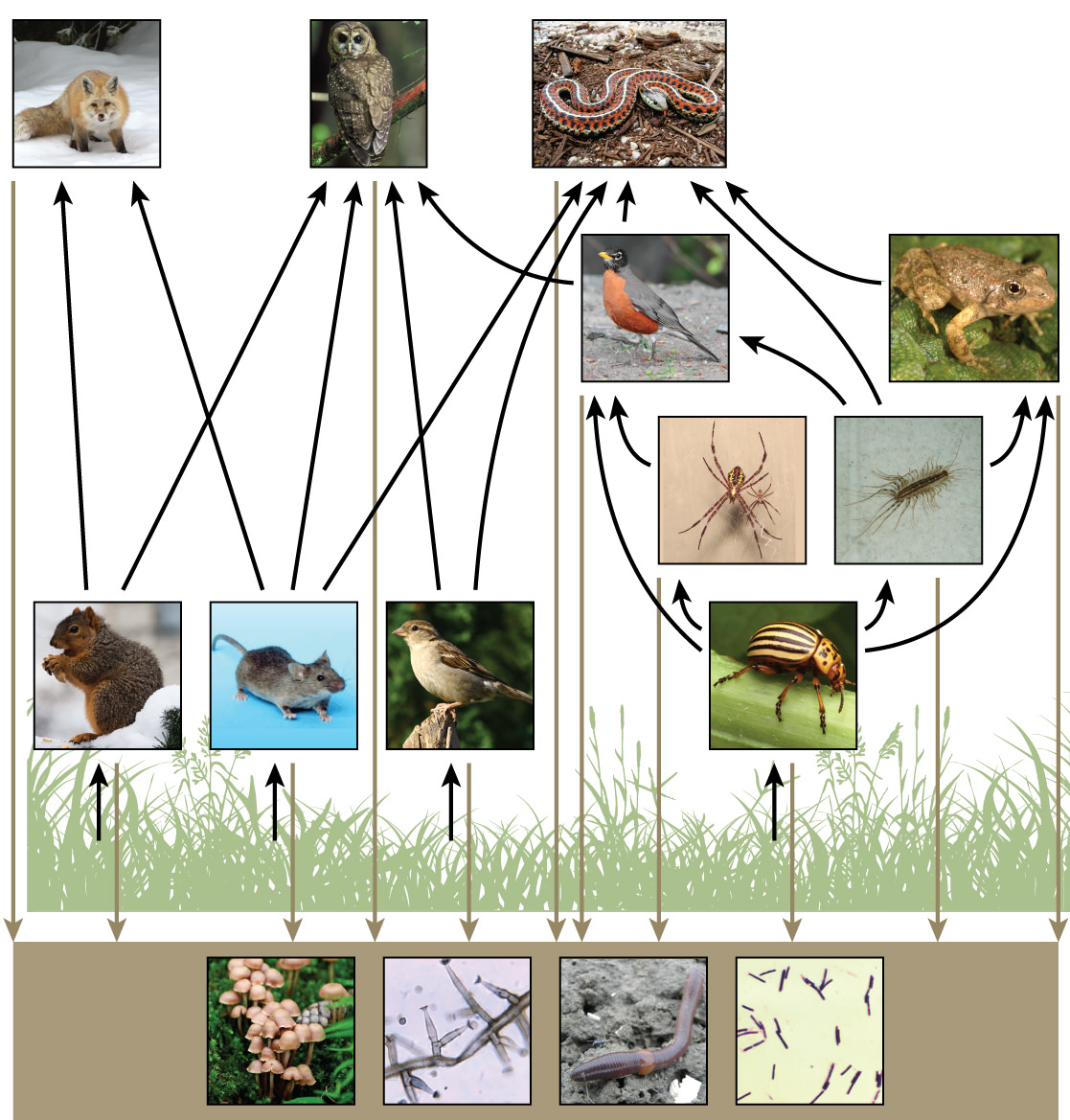
How Organisms Acquire Energy in a Food Web
All living things require energy in one form or another. At the cellular level, energy is used in most metabolic pathways (usually ATP), especially those responsible for building large molecules from smaller compounds. Living organisms would not be able to assemble complex organic molecules (proteins, lipids, nucleic acids, and carbohydrates) without constant energy input.
Food-web diagrams illustrate how energy flows directionally through ecosystems. They can also indicate how efficiently organisms acquire energy and use it and how much remains for use by other food web organisms. In two ways, energy is acquired by living things: autotrophs harness light or chemical energy, and heterotrophs acquire energy through the consumption and digestion of other living or previously living organisms.
Photosynthetic and chemosynthetic organisms are autotrophs capable of synthesizing their own food (specifically, using inorganic carbon as a carbon source). Photosynthetic autotrophs (photoautotrophs) use sunlight as an energy source, and chemosynthetic autotrophs (chemoautotrophs) use inorganic molecules as an energy source. Autotrophs are critical for ecosystems because they occupy the trophic level containing producers. Without these organisms, energy would not be available to other living organisms, and life would not be possible.
Photoautotrophs, such as plants, algae, and photosynthetic bacteria, are the energy source for a majority of the world’s ecosystems. Photoautotrophs harness the Sun’s solar energy by converting it to chemical energy. The rate at which photosynthetic producers incorporate energy from the Sun is called gross primary productivity. However, not all of the energy incorporated by producers is available to the other organisms in the food web because producers must also grow and reproduce, which consumes energy. Net primary productivity is the energy that remains in the producers after accounting for these organisms’ metabolism and heat loss. The net productivity is then available to the primary consumers at the next trophic level.
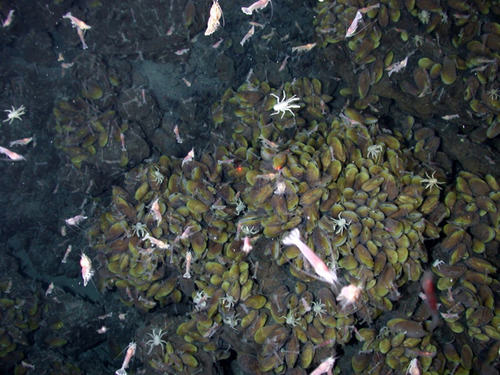
Chemoautotrophs are primarily bacteria and archaea found in rare ecosystems where sunlight is unavailable, such as those associated with dark caves or hydrothermal vents at the bottom of the ocean (Figure 6). Many chemoautotrophs in hydrothermal vents use hydrogen sulfide (H2S), released from the vents, as a source of chemical energy. This allows them to synthesize complex organic molecules, such as glucose, for their own energy and, in turn, supplies energy to the rest of the ecosystem.
Biomagnification is one of the most important consequences of ecosystem dynamics in terms of human impact. Biomagnification is the increasing concentration of persistent, toxic substances in organisms at each successive trophic level. These are substances that are lipid soluble and are stored in the fat reserves of each organism. Many substances have been shown to biomagnify, including classical studies with the pesticide dichlorodiphenyltrichloroethane (DDT), which was described in the 1960s bestseller Silent Spring by Rachel Carson. DDT was a commonly used pesticide before its dangers to apex consumers, such as the bald eagle, became known. DDT and other toxins are taken in by producers and passed on to successive levels of consumers at increasingly higher rates. As bald eagles feed on contaminated fish, their DDT levels rise. It was discovered that DDT caused the eggshells of birds to become fragile, which contributed to the bald eagle being listed as an endangered species under U.S. law. The use of DDT was banned in the United States in the 1970s.
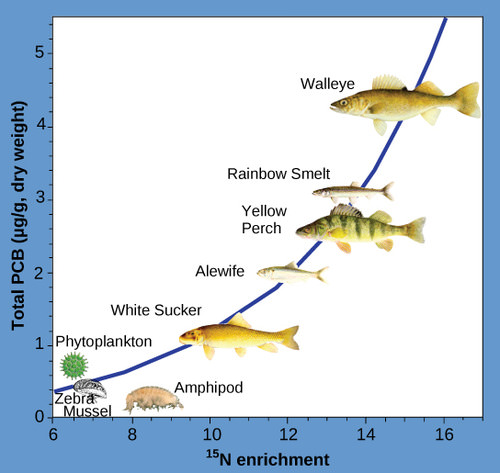
Another biomagnified substance is polychlorinated biphenyl (PCB), used as a coolant liquid in the United States until its use was banned in 1979. PCB was best studied in aquatic ecosystems where predatory fish species accumulated very high concentrations of the toxin that otherwise exists at low environmental concentrations. As illustrated in a study performed by the NOAA in the Saginaw Bay of Lake Huron of the North American Great Lakes (Figure 7 below), PCB concentrations increased from the producers of the ecosystem (phytoplankton) through the different trophic levels of fish species. The apex consumer, the walleye, has more than four times the amount of PCBs compared to phytoplankton. Also, research found that birds that eat these fish may have PCB levels at least ten times higher than those in lake fish.
Other concerns have been raised by the biomagnification of heavy metals, such as mercury and cadmium, in certain types of seafood. The United States Environmental Protection Agency recommends that pregnant women and young children should not consume any swordfish, shark, king mackerel, or tilefish because of their high mercury content. These individuals are advised to eat fish low in mercury: salmon, shrimp, pollock, and catfish. Biomagnification is a good example of how ecosystem dynamics can affect our everyday lives, even influencing our food.

